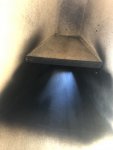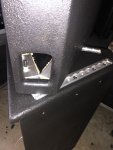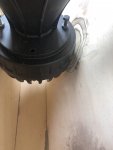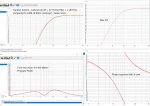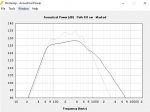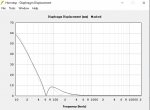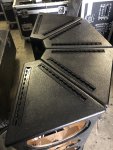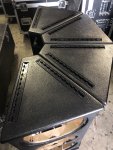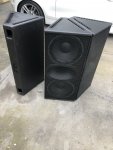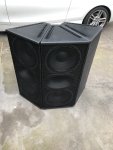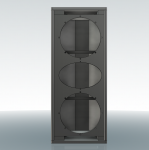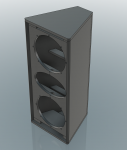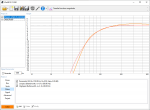This is more or less an up date of my double 10 and horn design. It’s the same height and when multiple boxes are packed front to back it takes up about the same amount of truck space.
I often see people wanting use 2 or more boxes together to get more power, but they never array very well. The idea was to build a 60 x 40 degree box that could be tight packed and array with a lot less issues.
It’s a MTM design in a trapezoidal box. It has uneven angles - 25 degrees and 15 degrees. By doing this I can place 2 boxes side by side and have a total splay of 50 degrees with all the drivers very close together minimizing comb filtering issues.
It’s necessary to have the other side at 15 degrees to get enough volume in the box. There is not enough room on the front of the box for reflex ports and they are located on the back, one on the top, and one on the bottom. They also work as a handle and add bracing to the walls.
You can array 3 or more boxes with 40 degree splay between the boxes.
To get 25 degrees it’s necessary to machine the inside wall of the box on one side to fit the compression driver in.
It uses:
2 x B&C – 12HPL76 (I had these in stock and it was too difficult to get other drivers due to COVID-19)
1 x B&C DCX464
1 x Ciare PR614 horn
Processing – I’m using Linea Research ASC48 with LIR crossovers and FIR processing, but it should be very easy to get good results with other processors.
It designed to operate from 80Hz to 20K with a mid crossover frequency around 675Hz and 3250Hz for the VHF. In my case the mid crossover overlap by 100Hz (at the moment).
The plan is to build some MID-HI passive crossovers eventually ... more to come
I often see people wanting use 2 or more boxes together to get more power, but they never array very well. The idea was to build a 60 x 40 degree box that could be tight packed and array with a lot less issues.
It’s a MTM design in a trapezoidal box. It has uneven angles - 25 degrees and 15 degrees. By doing this I can place 2 boxes side by side and have a total splay of 50 degrees with all the drivers very close together minimizing comb filtering issues.
It’s necessary to have the other side at 15 degrees to get enough volume in the box. There is not enough room on the front of the box for reflex ports and they are located on the back, one on the top, and one on the bottom. They also work as a handle and add bracing to the walls.
You can array 3 or more boxes with 40 degree splay between the boxes.
To get 25 degrees it’s necessary to machine the inside wall of the box on one side to fit the compression driver in.
It uses:
2 x B&C – 12HPL76 (I had these in stock and it was too difficult to get other drivers due to COVID-19)
1 x B&C DCX464
1 x Ciare PR614 horn
Processing – I’m using Linea Research ASC48 with LIR crossovers and FIR processing, but it should be very easy to get good results with other processors.
It designed to operate from 80Hz to 20K with a mid crossover frequency around 675Hz and 3250Hz for the VHF. In my case the mid crossover overlap by 100Hz (at the moment).
The plan is to build some MID-HI passive crossovers eventually ... more to come
Attachments
Last edited:


